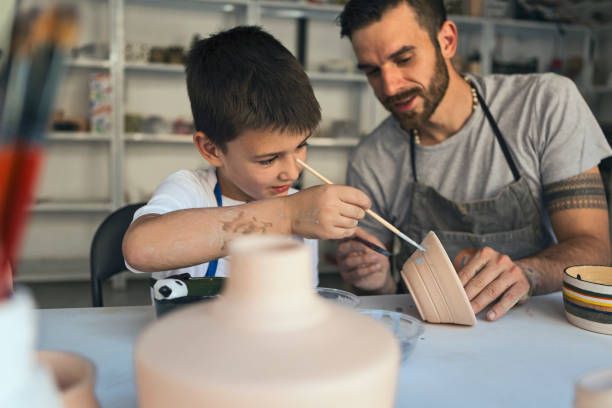betty@kaihong888.com

Get A Quote
A Guide to Ceramic Painting for Beginners
For beginners, ceramic painting serves as an excellent introduction to the world of art and creativity. It provides an accessible and enjoyable way to explore artistic expression while learning fundamental techniques and skills. Moreover, ceramic painting offers a tangible outcome, allowing beginners to create functional and decorative pieces that they can proudly display or gift to others.
Getting Started with Ceramic Painting
Understanding Different Types of Ceramics
Ceramics come in various types, each with its own characteristics and suitability for painting.
- Earthenware: This type of ceramic is commonly used for painting due to its affordability and accessibility. It's easy to work with and offers a porous surface that absorbs paint well.
- Stoneware: Although slightly more expensive, stoneware is known for its durability and strength. It provides a stable base for painting and results in a long-lasting finished product.
- Porcelain: Considered the most challenging type of ceramic to paint, porcelain features a smooth and slippery surface that requires specialized techniques for adhesion.
Choosing the Right Materials and Tools
Selecting the appropriate materials and tools is crucial for a successful ceramic painting project.
- Types of Ceramic Paints: There are several options available, including underglaze, overglaze, and paint pens. Underglaze is applied before firing, while overglaze is used afterward. Paint pens offer convenience for small details.
- Essential Tools and Supplies: Ensure you have the necessary equipment, such as paintbrushes, sponges, palette knives, and a palette for mixing colors. Additionally, you'll need a kiln for firing, glazes for finishing, and a clay cleaning tool for preparation.
Preparing Your Ceramic Piece for Painting
Proper preparation of the ceramic surface is essential for achieving optimal results in painting.
- Cleaning the Surface: Begin by cleaning the ceramic piece with soap and water to remove any dirt or residue. This ensures a clean canvas for painting and promotes better adhesion of the paint.
- Sanding for Better Adhesion: Lightly sanding the surface with fine-grit sandpaper helps create a rough texture that allows the paint to adhere more effectively. This step is particularly important for glazed ceramics, as it enhances the paint's bond to the surface.
Basic Ceramic Painting Techniques
Layering Colors
Layering colors is a fundamental technique in ceramic painting that involves applying multiple coats of paint to achieve depth and dimension. Start with a base color and gradually add layers of complementary or contrasting colors to create visual interest and complexity in your artwork.
Blending Colors
Blending colors allows you to seamlessly transition between different hues, creating smooth gradients and subtle transitions. Use a wet-on-wet technique or mix colors directly on the ceramic surface to achieve the desired blend. Experiment with different brush strokes and pressure to control the blending effect.
Adding Textures
Adding textures to your ceramic pieces can enhance their visual appeal and tactile quality. Experiment with various tools and techniques, such as stippling, sponging, or dragging, to create interesting textures and patterns. Incorporating texture can add depth and richness to your paintings, making them more dynamic and engaging.
Experimenting with Different Brush Strokes
Brush strokes play a crucial role in ceramic painting, as they determine the texture, shape, and style of your artwork. Explore different brush strokes, such as stippling, cross-hatching, or dry brushing, to achieve different effects and expressions. Varying the pressure, angle, and direction of your brush strokes can produce unique and compelling results.
Exploring Various Painting Techniques
In addition to traditional brush painting, there are various other painting techniques you can explore in ceramic painting. These include sgraffito, marbling, resist, and splattering, among others. Each technique offers its own unique challenges and possibilities, allowing you to experiment and push the boundaries of your creativity.
Tips and Tricks for Beginners
Starting with Simple Designs
Begin your ceramic painting journey by starting with simple designs. This allows you to focus on mastering basic techniques and building confidence before tackling more complex projects. Start with geometric shapes, floral patterns, or abstract designs to ease into the process.
Practicing Patience and Attention to Detail
Patience is key in ceramic painting. Take your time to ensure each brushstroke is deliberate and precise. Pay attention to details and strive for perfection in every aspect of your artwork. Remember, Rome wasn't built in a day, and neither is a masterpiece.
Cleaning Brushes Thoroughly
Proper brush care is essential for maintaining the quality and longevity of your brushes. After each use, clean your brushes thoroughly with soap and water to remove any paint residue. Reshape the bristles and allow them to air dry completely before storing them away. This simple step helps prevent paint buildup and ensures your brushes remain in top condition for future use.
Exploring Colors and Designs
Choosing a Color Palette
Selecting the right color palette is crucial for achieving the desired mood and aesthetic in your ceramic pieces. Consider the theme, style, and intended use of your artwork when choosing colors. Experiment with different color combinations to find what resonates with you and enhances your design.
Drawing Inspiration from Ceramic Tile Designs
Ceramic tile designs offer a wealth of inspiration for your own ceramic painting projects. Draw inspiration from traditional motifs, cultural patterns, or contemporary designs found in ceramic tiles. Analyze the use of color, shape, and composition in these designs to inform your own creative process.
Trying Out Different Designs and Patterns
Don't be afraid to step outside your comfort zone and experiment with different designs and patterns. Whether it's intricate mandalas, bold geometric shapes, or whimsical motifs, exploring diverse styles can spark creativity and help you discover your artistic voice. Embrace the opportunity to push boundaries and express yourself through your artwork.
Encouraging Creativity and Personal Style
Above all, embrace your creativity and cultivate your personal style in ceramic painting. Allow yourself the freedom to express your unique perspective and artistic vision. Whether you prefer vibrant colors, minimalist designs, or intricate details, let your creativity shine through in every brushstroke. Remember, the beauty of ceramic painting lies in its ability to reflect your individuality and creativity.
Conclusion
Ceramic painting is a rewarding and creative art form that offers endless possibilities for self-expression. Whether you're a beginner or an experienced artist, exploring different techniques, experimenting with colors and designs, and honing your skills can lead to beautiful and unique ceramic pieces.
To embark on your ceramic painting journey, I highly recommend considering KHY's Ceramic Painting Products. With a wide range of high-quality paints, brushes, and other accessories, KHY provides everything you need to bring your creative vision to life. Their products are designed to meet the needs of both beginners and experienced artists, ensuring excellent results and long-lasting satisfaction.
So why wait? Start your ceramic painting adventure today with KHY and unleash your creativity on ceramic canvas!

